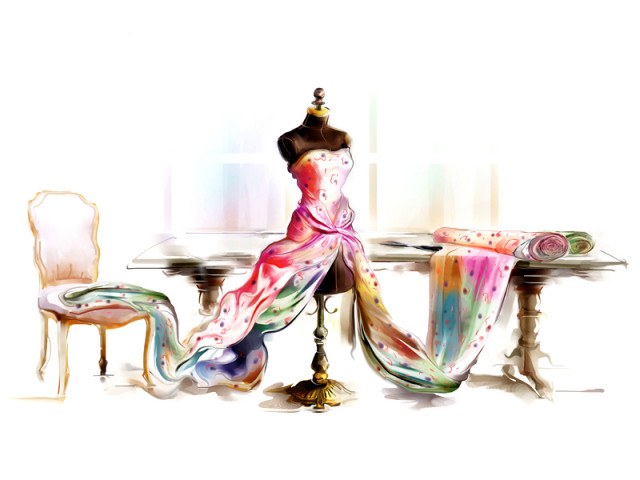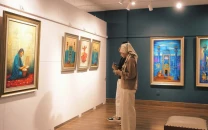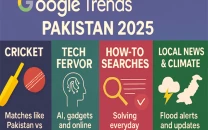Recipe for success: Talent or technicality?
Fashion designers talk about how important it is to be trained before one can step into the world of fashion.

Fashion designers talk about how important it is to be trained before one can step into the world of fashion. DESIGN: KIRAN SHAHID
Despite having a booming fashion industry and a rapidly growing number of designers, Pakistan has only a handful of fashion schools to hone the raw talent of aspiring designers.
There are only four major art schools in the country, out of which two focus mainly on fashion design; the Pakistan Institute of Fashion and Design in Lahore and Asian Institute of Fashion Design in Karachi.
Many may argue that anybody who has the talent and eye for fashion can make a mark in this field. They might even criticise the concepts and collections of fashion grads for being “eccentric” and inappropriate for daily wear. But talk to people in the field and they’ll tell you what’s more important between training and sensibility. The Express Tribune talks to the big names in fashion about candidates that are part of a winning team.
Fashion grads are a must!
While the industry comprises a number of designers who do not have a design background, many feel that the importance of academic and professional training is undeniable. Popular Lahore-based designer Kamiar Rokni believes that one can’t “be in the fashion business without a sense of aesthetics”. He feels that it’s sensibility alone is not sufficient, and that academic knowledge is also required. “You need to have an eye and that eye needs to be developed further by training. Trained designers, who have changed the fashion scene in Pakistan ever since the millennium, are proof,” he said.

Talented Nida Azwer who has risen to fame quite quickly, stresses that a combination of both style and training is needed to succeed. “It’s a combination of both. You need to have good aesthetics but at the same time you also require professional training,” she said. “It always gives you an upper hand if you have professional training in fashion/textile when entering the fashion industry.” Rabia Wahab, the woman behind Fiction Concepts and a textile major from Indus Valley School of Arts and Architecture firmly believes that fashion graduates definitely have an edge over others because they are constantly developing, since they receive criticism from teachers and end up becoming confident.
And the best school is…
It is evident that designers from Lahore have a soft corner for PIFD grads whereas those belonging to Karachi prefer AIFD students. Regardless of the dearth of fashion schools in Pakistan, the competition is intense and with senior designers having their own special preferences, it gets all the more formidable. Rokni’s slight tilt towards PIFD is based on technical expertise. “Different people have different strengths but graduates from PIFD tend to be technically astute and that is something that we look for.” Rabia, on the other hand, believes that AIFD students have the ability to stand out, even though she studied from IVS. “Graduates from IVS are basically graduates in textile design. Graduates from AIFD are graduates in both textile and fashion, which gives you the advantage of knowing pattern design and stitching that pure textile designers lack,” she says.
Any hope for the untrained?
Considering what has been discussed, it may seem that all hope is lost for those who did not opt for a degree or a course in fashion. Of course, trained designers are better equipped and more aware about techniques involved in design. But does that mean designers who do not have an academic background in fashion cannot be equally successful? Safinaz Muneer of the fabulous SanaSafinaz label only attended the National College of Arts for a year, and says technical expertise is “not necessary”. “Creativity is in born – talent matters,” she says. Coming from one of the biggest names in fashion in the country, we’ll say that’s authority enough. Every bride’s dream wedding dress designer Bunto Kazmi has no fashion degree but thousands of clients and years of experience.
With so many talented young people stepping into the fashion industry having just sheer passion and not the relevant training, one can surely not suggest that skills are the main criteria. Feeha, too, agrees by saying, “It is very important to know aesthetics but it is even more important to have individual style or you will get lost in the common sea of being technically and skillfully right and will therefore be following trends instead of creating trends.” She added, “It is imperative to have the skill but what is more important is to challenge that skill. An eye for fashion is way more important than the skill itself.”
Published in The Express Tribune, May 23rd, 2013.
Like Life & Style on Facebook for the latest in fashion, gossip and entertainment.


















COMMENTS
Comments are moderated and generally will be posted if they are on-topic and not abusive.
For more information, please see our Comments FAQ